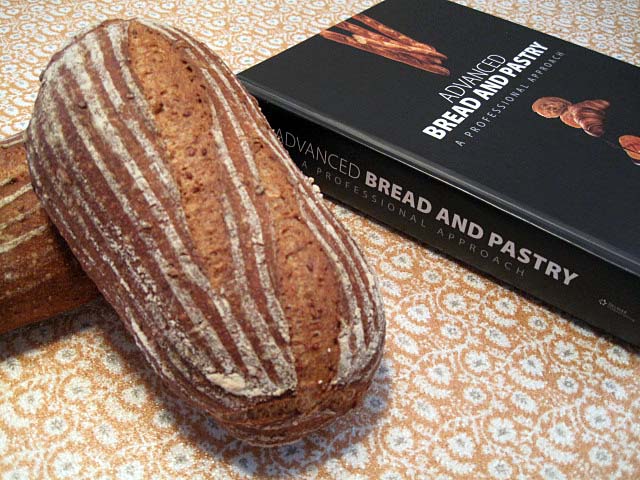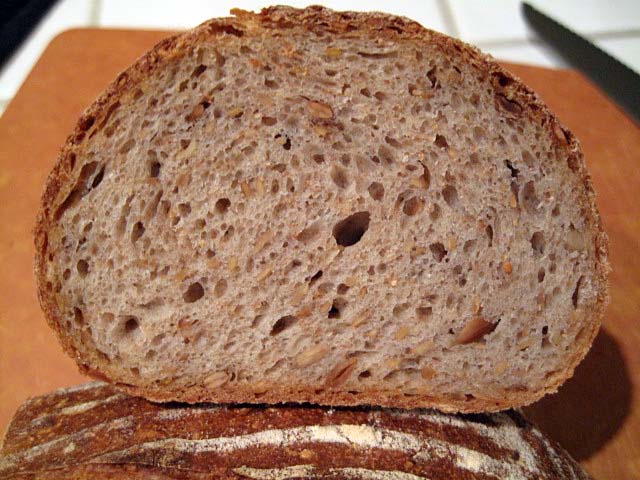Multigrain sourdoughs have a delightful complexity of flavor, wonderful texture and phenomenal keeping quality because of the moisture retained in the soaker, as well as the effect of the levain. They are delicious fresh-baked, but their flavor only fully develops after a day or two when the distinctive flavors of the grains and seeds have had a chance to meld.
I had made Jeffrey Hamelman's 5-grain Levain from “Bread” a number of times. Hamelman describes the flavor as “delectable,” which is not an over-statement. So, although my original intent was to make the Sourdough Whole Wheat Bread from Michel Suas' “Advanced Bread and Pastry” this weekend, when I saw his formula for “Sourdough Multigrain Bread” a few pages later, I couldn't resist it.

|
Levain |
|
|
|
Ingredient |
Amount (Lbs & Oz) |
Bakers' % |
|
Bread flour |
2 5/8 |
95 |
|
Medium rye flour |
1/8 |
5 |
|
Water |
1 3/8 |
50 |
|
Starter (stiff) |
2 1/8 |
80 |
|
Total |
6 1/4 |
230 |
-
Mix all ingredients well with a DDT of 70ºF. (Tip: First mix the water and starter completely. I find a dough whisk is great for this. Then add the flours and mix thoroughly.)
-
Ferment 12 hours at room temperature.
|
Soaker |
|
|
|
Ingredient |
Amount (Lbs & Oz) |
Bakers' % |
|
Flax seeds |
1 1/2 |
39.13 |
|
Sunflower seeds |
1 1/2 |
39.13 |
|
Rolled oats |
1 1/2 |
39.13 |
|
Sesame seeds |
1 1/2 |
39.13 |
|
Water |
3 7/8 |
100 |
|
Total |
9 7/8 |
256.52 |
-
Toast the Sunflower and Sesame seeds for 4-6 minutes at 350ºF to bring out their flavor.
-
Suas says to soak the seeds and oats for at least two hours. I soaked them overnight.
|
Final Dough |
|
|
|
Ingredient |
Amount (Lbs & Oz) |
Bakers' % |
|
Bread flour |
10 1/8 |
65 |
|
Whole wheat flour |
3 7/8 |
25 |
|
Medium rye flour |
1 1/2 |
10 |
|
Water |
11 3/8 |
72.8 |
|
Yeast (instant) |
1/8 |
0.16 |
|
Salt |
3/8 |
2.53 |
|
Soaker |
9 7/8 |
59 |
|
Levain |
6 1/4 |
40 |
|
Total |
2 lb |
274.49 |
Method
-
Make the levain the night before baking and ferment it overnight, as above.
-
Mix the flours, water, yeast and salt.
-
Add the levain and mix thoroughly.
-
Mix to medium gluten development, then add the soaker and mix only until incorporated. DDT is 75-78ºF (24-25ºC).
-
Ferment for 2 hours.
-
Divide into two equal pieces and pre-shape into loose balls.
-
Rest the pieces, covered, for 20-30 minutes.
-
Shape as bâtards. (Gently pat each ball of dough into a disc. Fold the right and left sides to meet in the middle. Then, roll the pieces up, away from you. Make sure the seam is sealed as you roll the loaves into bâtards and place in well-floured bannetons or on a floured couche.)
-
Cover tightly and proof f or 60-90 minutes at 80ºF.
-
One hour before baking, pre-heat the oven to 500ºF with a baking stone and your preferred steaming method in place.
-
When the loaves are expanded by 75%, transfer them to a peel and to the baking stone.
-
Immediately steam the oven and turn the temperature down to 460ºF.
-
Bake for 30-40 minutes or until the internal temperature is at least 205ºF and the bottom sounds hollow when thumped.
-
When the loaves are fully baked, turn off the oven, but leave the loaves on the stone with the oven door ajar for 5-10 minutes to dry the crust.
-
Transfer the loaves to a cooling rack, and cool thoroughly before slicing.

This bread has a crunchy crust and chewy crumb. There is a distinct but mild sourdough tang, and the flavor of the oats and seeds is very present. Compared to Hamelman's 5-grain Levain, Suas' bread has a higher proportion of seeds, and I toasted the sesame and sunflower seeds darker than I had for Hamelman's bread. Suas also uses a firm starter while Hamelman uses a liquid starter, which accounts for the relative sourness of Suas' bread.
While the comparisons are interesting, I can't say either is “better.” Both are outstanding breads and highly recommended.
David
Submitted to YeastSpotting
- dmsnyder's Blog
- Log in or register to post comments
and thorough presentation. You have trained us to expect no less, and you never dissappoint. Your pictures show a beautiful loaf, and I love the look of the seeds peeking out of the crumb. Breakfast toast will be special tomorrow! I've been gaining weight tonight just looking and reading! Well done, indeed!
I noticed that the formula calls for bread flour, not All Purpose. Is this because of the seemingly large quantity of seeds disturbing the structural efficiency of the loaf, or requiring more structure because of their non-contributing weight? It does not appear, to my still inexperienced eye, that there is enough whole wheat flour in the formula to require the bread flour on that basis alone.
Thanks for a beautiful loaf well presented.
OldWoodenSpoon
I appreciate your kind words.
I suppose you are correct regarding Suas' choice of flours. The bread flour also makes this a very chewy bread. And I agree that these seeded breads make terrific toast. However, tomorrow's breakfast is most likely going to be French toast made with the San Joaquin Sourdough I also baked today.
David
I have had the experience of making Hamelman's multigrain levain a few times as well, and also a sourdough variation of Reinharts multigrain and I am going to agree, the depth of flavor in multigrains sourdough loaves are wonderful! They offer so much!
Your loaves look fantastic David, your a very talented baker!
Your bread looks amaizing, great picture! My last starter didn't work out great, but your bread really inspires me to give it another shot. Thanks.
Janice
I am a big fan of multigrains myself, especially Hamelman's Five-grain Levain; in fact, I had a slice toasted with almond butter this morning for breakfast! I must have missed the note on toasting the sunflower and sesame seeds before assembling the soaker. My guess is it will provide an even nuttier-flavoured loaf?
Thanks for sharing your notes on Suas' Sourdough Multigrain Bread; I'll be sure to give it a try.
- Jackie
Beautiful, David. I can't wait to get back to baking.
Man, I hope you can get back to baking soon, both for your sake and because it would mean the acute need for Mercy Corp's efforts in Haiti has lessened.
David
I particularly like the crumb... so open with grains peeking out. Lovely! Al
David
We made this bread in class at SFBI and there was no one who did not love it. You did a beautiful job, David.
Regarding the flour: almost all of the bread formulas in Michel's book call for "bread flour" but unfortunately the term has no standard meaning. At SFBI (and in Michel's book), the flour used for bread typically contains around 11.5% protein (ranging from 10.5-12%), which is lower than the protein content of most flours sold in the US as "bread flour." King Arthur AP and Whole Foods 365 are two flours that would be considered "bread flours" for the purposes of the Advanced Bread And Pastry formulas.
I know ... flour terminology is an issue in Hamelman's "Bread" and AB&P as well. Glazer, at least, generally discusses the desirable protein content of flours in the breads she discusses in "Artisan Baking."
As far as Michel Suas' book goes, I am not sure what is a "message" and what is an editing issue. For example, in his formula for San Francisco Sourdough, the levain formula calls for "bread flour" while the Final dough formula calls for simply "flour."
Anyway, thanks for your kind words.
David
These multi grain loaves look so wholesome. Yours is beautiful.
Eric
Something this healthy could taste so good?
I just had a slice with almond butter for bedtime snack. My tummy liked it, and my arteries did too. ;-)
David
Thank you for this. I'd like to give it a try. Please forgive me if I am missing something extremely basic, but your ingredients for the final dough add up to more than 32 ounces (2 lbs,) which is the total you give. Of course, it is entirely possible that I have added wrong, or something equally plain. Could you please clarify this? Many thanks.
The ingredients total more than 2 lbs. I copied directly from "Bread." I can only speculate regarding the deeper meaning of the error, since Hamelman does this quite regularly with the "home" version of his formulas.
David
An interesting quirk. I'll stay away from the deeper meaning as well. Thanks for the clarification.
David,
Last week I was asked by my gourmet group to make a multigrain bread. After looking around in TFL, I remembered that I had put your index in my favorites and saw the multigrain bread there from Advanced Bread and Pastry. I followed the recipe except I used rye and barley flakes which I happed to have plus the flax, sesame and sunflower seeds. I ran out of time to bake, so I let the shaped batard rise for an hour and then refrigerated it for about 14 hours and then slashed and baked straight from cold to the oven. The bread felt a little poofy. I think I should have not let is rise so much before retarding. The result, in any case, was almost perfect, at least for me and my friends. The taste, best I have ever made. Unfortunately, I have been trying for hours to post pictures, without success. I did it once with Shiao Ping's help, but forget how, inspite of written instructions. May be when my daughter returns home from Korea next month, I will get the kid's help!
I have a question for you. My breads taste great because I am a good copy-cat and thanks to all the gurus at TFL. What brotform do you use to make your breads look so perfect. I would rather not get the cloth lined because that will not create the lines. I have looked on Amazon and dont know how much I should spend on basically getting two, one round and one oval. They range anywhere from $18 - 50's, plus shipping. I would appreciate your sage advice. Thanks
Salma